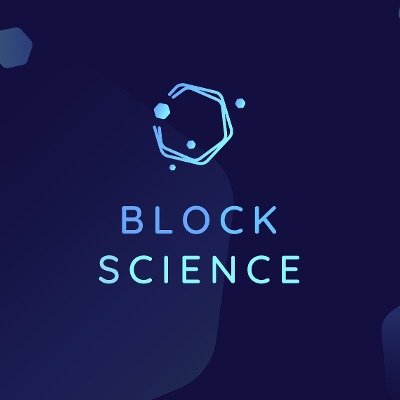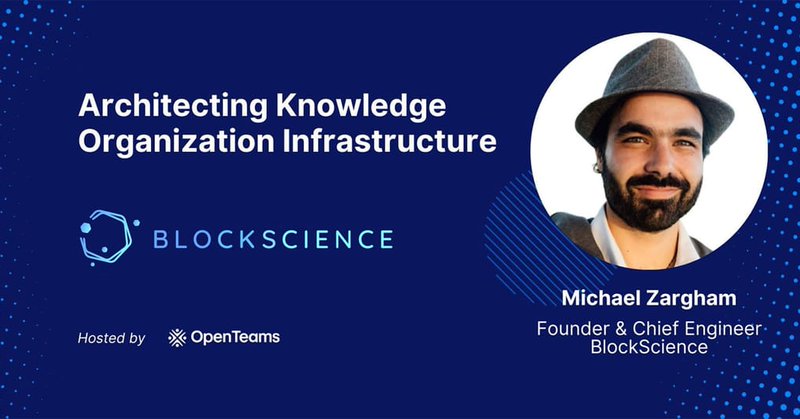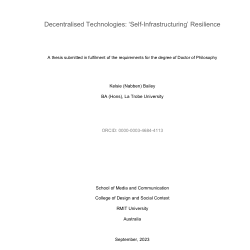
BlockScience
@block_science
Followers
6K
Following
6K
Media
262
Statuses
2K
BlockScience® is a systems engineering firm that operationalizes emerging technologies for high reliability organizations.
Philadelphia, PA
Joined October 2017
📚From the Archive. Digital objects serve as the units of organization that enable meaningful communication, representation & interaction. in a sense the most basic shared ontology which mediates coordination between humans & digital systems @OrionReedOne
blog.block.science
Towards first principles to guide, develop & understand new forms of digital organization & cyber-infrastructure in terms of objects as reference.
0
0
0
RT @docmilanfar: The representer theorem is fundamental in ML - it states that for a broad class of optimization problems, the optimal solu….
0
74
0
@mZargham @openteamsinc @metagov_project 6/ KOI Pond is the exciting thing here: organizing all our different knowledge organization tools into a coherent system that supports the accessibility & discoverability of @metagov_project local knowledge.
2/ #LLMs are not an end unto themselves; It is the infrastructure underneath that makes the LLM useful by referencing existing knowledge, where it exists, where people work. Composable | Interoperable | #OpenSource . @OrionReedOne @mzargham.Demo:
0
0
2
@mZargham @openteamsinc 5/ In practical terms, our @metagov_project collaboration provides an operating context to discuss the challenges & opportunities of knowledge organization infrastructure.
Knowledge networks that can outcompete large institutions -especially w/regard to #innovation - can only emerge from collaborative coordination between peers. Thank you @ElinorRennie & @metagov_project for helping bridge the gap between today's tech & future ways of collaborating.
1
0
2
@mZargham @openteamsinc 4/ @mzargham discusses KOI from a systems engineering perspective in terms of. - Conceptual architecture .- Practices, algorithms, & world models.- Organizational & environmental interfaces.- Social mileu authority, policies, administration, system & technical setting
Conceptual Architecture: . The high-level vision or abstract framework of a system defining the purpose, key objectives, and major components without specifying their implementation details. It focuses on the "what" and "why" of the system
1
0
2
@mZargham @openteamsinc 3/ KOI encompasses the technical & social components required to ensure that knowledge is discoverable, accessible, reliable, & actionable to serve its stakeholders' wants, needs, & limitations such as the resources needed to maintain & use the pool of knowledge.
Why is there Data?. In order for data to become truly valuable (& truly useful), that data must first be processed, which begs the question; What sort of processing must data undergo, in order to become valuable?. By David Sisson & @ilanagain (2024).SSRN:
1
1
2
@mZargham @openteamsinc 2/ What is KOI?. Knowledge organization infrastructure (KOI) is systems, tools, processes, rules, & governance mechanisms that enable the collection, curation, management, sharing, & utilization of knowledge within a specific operating context.
1
0
2
Want to explore how Knowledge Organization Infrastructure (KOI) can empower your organization?. 💡 Core principles .💡 Transformative impact.💡 Real-world case studies .💡 Practical strategies . w/ @mZargham @openteamsinc #opensource architects.
blog.block.science
Watch Dr. Zargham present a systems engineering perspective on how we design, implement, operate & govern knowledge organization infrastructures.
1
0
2
Bottom line: LLMs are tools — complex but not mystical. Understanding their foundations is key to building better systems. 🔗 Full article:
blog.block.science
Explores the foundations of LLM systems, fundamental building blocks, integration of RAG models & the place of LLMs in the future technological landscape.
0
0
1
🧵Understanding Large-Language Models .What’s actually happening under the hood?. - Tokens.- Context Window.- Vector Stores.- Reasoning Models.- Structured Output. 🔗 Here’s a primer:.
blog.block.science
Explores the foundations of LLM systems, fundamental building blocks, integration of RAG models & the place of LLMs in the future technological landscape.
1
2
2
RT @block_science: 1/ Exploring the complex ways norms & institutions overlap as distinctly important classes of rules that govern human so….
0
3
0
RT @kelsiemvn: PhD IS OUT! My 2023 PhD was embargoed due to book negotiations. Here it is, finally free: Decentralised Technologies: ‘Self-….
research-repository.rmit.edu.au
This thesis focuses on how groups of people build, use, and experience infrastructure in the digital era by investigating the resilience of decentralised technologies for people that use them. Here,...
0
18
0
🎥 From the Archive. By automating technical, systematic methods for making decisions, we can embed & abstract them away from end users & provide people the benefit of higher validity methods, without the need to understand that they are there. 00:01:32
blog.block.science
Video playlist on engineering systems, cybernetic steering, and the roles of humans and infrastructure within complex adaptive networks
0
0
3
Ultimately, successful AI is about robustness, adaptability, & alignment with real-world needs. By treating AI development w/ the same care as civil infrastructure, we can create systems that are technically sound, & socially & operationally responsible.
@mZargham As engineered systems, AI agents are not self-governing; they are provisioned, deployed, & monitored by humans who remain ultimately accountable for their behavior. Both discussions provide valuable insights for anyone involved in developing, deploying, or regulating AI
0
1
1
While failure is essential for learning in the lab, the standard shifts for production. AI systems must undergo rigorous testing against real-world outcomes, not just benchmarks. Deployment should only occur after a system is proven fit for its intended environment.
@mZargham The Problem of 'Validation'. ML "validation" is often verification (performing well against internal objectives). But a system can look excellent on paper & fail in the real world. Is the model achieving its intended purpose? That's true validation.
1
0
0














